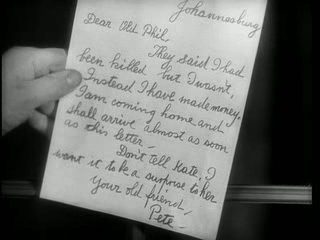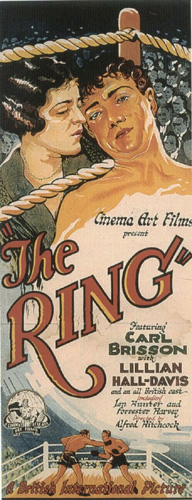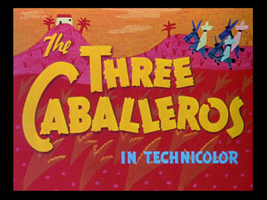
ADAM I don’t have any idea what to say!
BROOM We weren’t stoned in any way, but I feel kind of like we were.
ADAM Yeah, I feel weirdly intoxicated right now. When it started, I thought, “oh, some cheerfully stupid shorts.” And they were unusually cheerful and stupid, even by the standards of the preceding movie. I forget now what the first one was.
BROOM Pablo the penguin was the first part, and then there was the little Gauchito and the flying donkey.
ADAM And both of those were like, “ehhh, here’s a thing we thought of.”
BROOM Yeah, they were really dumb, and while we were watching those I was thinking that you could really feel the studio having taken a downturn since the previous movie. I felt like Saludos Amigos had a higher standard of intelligence throughout, and that this really settled for “dumb” in those first couple of sequences.
ADAM Well, I thought that the first couple were awfully jovial, which made up for the fact that they were like, “ehhh… here’s this story… and nothing happens… and… woo!” Particularly the ending to the flying donkey one, where they build up to the climax of the action, and suddenly the next line is “I bet you’re wondering what happened to the flying donkey. He and I were never seen again for the rest of our lives!” So I thought, “well, okay, it’s ridiculous, but…”
BROOM Saludos Amigos was explicitly about good relations with South America, and they explained what they were doing; this never explained what its purpose was, so when they show you a stupid story about a penguin going to the Galapagos – which is only remotely related to South America…
ADAM It was very instructive about the western coast of South America and its many features!
BROOM …if it had an educational purpose, it was not made clear to us what that was. So while with Saludos Amigos I got to knowingly enjoy that “we’re learning about Argentina but we’re having fun at the same time,” here it just felt like “I don’t know why they’re showing me this!”
ADAM And that was only the first third of the movie…
BROOM Well, let’s talk about it in order.
ADAM First of all, the framing device was ridiculous.
BROOM It’s “a present from your South American friends.”
ADAM It’s three presents from your South American friends.
BROOM Yes. One from your South American friends, one from your Mexican friends, and one from your Antarctic friends.
ADAM No, that was really just “one about strange birds.” It wasn’t about a country. There was no parallelism at all.
BROOM Oh, you’re right. As for the frame, I want to say – the sequence with the piñata was included in some kind of Christmas special that we had on tape – it might have been something we taped from the “Disney Sunday Night Movie” slot at some point – and that sequence was part of some kind of present-receiving montage, and I always thought it looked cool. I liked that it was set in no-man’s-land, with just a weird pink and red background, just a place of pure fun. That indeterminate space where craziness happens. The same space where “Pink Elephants” takes place.
ADAM Where this movie started.
BROOM Right, where this whole movie basically takes place. Sure, there are episodes of the movie that go away from that space…
ADAM Not really – they don’t go anywhere real; they just get inside a pop-up book.
BROOM Well, that’s right, but on a film within the film we got to see Antarctica, and it was basically a mimetic Antarctica. But the movie really takes place in an abstract, conceptual space. And I thought that was cool when I was a kid. I thought I’d like to see that movie that takes place there, because the coolest parts of cartoons are always when things get crazy. So a whole movie that takes place in a world where there’s no division between the floor and the wall, or outdoor and indoor, where they’re just on top of a wash – that seemed promising to me.
ADAM But did you realize it was going to be a frenzied degeneration into lavishly frustrated sexual appetites?
BROOM No, I didn’t know that’s where it was going to go. Maybe I had read about Donald as a bee, or something, but I really didn’t know. Anyway. So the film about birds ended and then he went back to the box and got the second present, the Brazil pop-up book.
ADAM And José Carioca came out of it, and I thought, “okay…” – and then they were differently sized… it just started to disintegrate.
BROOM Then there was dancing with Carmen Miranda. [ed.: actually Aurora Miranda, Carmen’s sister]
ADAM It was right when she came around the bend – because before that it’s a cartoon shadow, and José Carioca says, “You think she’s pretty? Cookies, Donald! She sells cookies!” and suddenly it’s a real person! That’s when I knew we were in for something special. So then there was the dance sequence on the streets of Baía, where everyone joins in, even the buildings.
BROOM For all of their obvious interest in combining animation and live action, their technique wasn’t very good. You could see the layers either way they did it. When the people were in front, the animation looked out of focus; when the animation was in front, you could see the distance between the cel and the live action.
ADAM And the fact that they never interacted physically was glaringly obvious. Though I thought that in the Mexico sequences they did a better job. When he was at the beach being bounced on the blanket, and the women had convincing reactions to his physical presence.
BROOM The blanket was an inspired idea, and the fact that Donald was flying over their heads helped justify that he looked significantly closer than they were. But when Carmen Miranda – or whoever that was – kisses him at the end of the dance sequence, that was a let down, because they couldn’t really pull it off.
ADAM You don’t see anything!
BROOM Right, you don’t see any action. Much of this movie – even setting aside the psychedelic sequence at the end! – was about Donald’s lust for human women.
ADAM Donald’s never-realized lust for human women. Which was the earlier movie that invited the queer theory reading? Bambi? Because this really asked for it.
BROOM Oh please. It was sexualized, but what was gay about it? That they said “gay caballeros?”
ADAM No. But that scene at the end where he’s mooning over that singing woman’s face in the flower, and goes in to kiss it, and his buddies jump out of her face and embrace him? It wasn’t gay… but it was something.
BROOM It seemed like that whole sequence was saying, “you have some idea of beauty, your heart is stirred by lustful, lyrical feelings, and they get interrupted by the craziness of the world.” Donald’s lyrical, sexual drive kept being defeated by chaos.
ADAM It seemed like a wet dream to me, never quite consummated.
BROOM It was like a wet dream mixed with a fever dream. Every time you think you’re about to have sex in the dream, suddenly other dream shit happens and messes with you.
ADAM And the fact that that was in the same movie as the cute penguin sojourning from Antarctica…
BROOM It’s bewildering. But let’s try to break it down. Clearly the impetus for the movie to exist was similar to Saludos Amigos, even if it wasn’t commissioned by the government.
ADAM It was a goodwill enterprise.
BROOM With an edutainment spin on it. But given that project, they made such anti-educational choices. There was very little content, and a lot of it was repeated from the other movie. They again listed the components of the gaucho’s uniform. We already saw that!
ADAM And there were again sequences of people dancing.
BROOM That Mexican dance on the boards looked very similar, in fact, to the Argentine dances in Saludos Amigos.
ADAM And José Carioca shows up again to extol the shimmying beauty of a Brazilian city.
BROOM You mean “shimmering.”
ADAM No, I mean “shimmying.”
BROOM Oh, because the city shimmies.
ADAM Yes.
BROOM It feels almost like they might have been trying to actually re-do Saludos Amigos, but with a clearer commitment to making it all cartoons. “Let’s make that movie again; we made a mistake last time by having live action footage and a narrator explaining everything – this one’s going to place entirely in cartoon-land, in fantasy.” It seemed like that must have been the thought behind all these weird choices. A bad idea!
ADAM But if you set aside the idea of it being edutainment, and think of it as a Freudian descent into the underworld of the mind, there’s a definite sort of logical and inexorable progression from cheerful stories to… Satyricon, basically.
BROOM You can watch it that way, but it surely was not meant that way.
ADAM Surely it was meant that way by the animators who made it, because how on earth could they have made this movie without intending that?
BROOM Just from an exuberant desire to animate the things that animation lends itself to: things transforming into each other, bursting apart, suddenly multiplying… these are things that are fun for animators to think of and execute.
ADAM I would just like whoever’s reading this to know that during the climactic scene, I was weeping with embarrassed giggles.
BROOM We were giggling pretty hard through the whole second half of the movie. Wow. I’m still processing some of the things we saw.
ADAM I hope this serves as an advertisement to whomever is reading this. Because you probably wouldn’t think a collection of Disney shorts from the 40s is going to be as interesting as this.
BROOM It wasn’t really a collection of discrete shorts – there were those first two segments that stood apart, but everything after José Carioca showed up was pretty coherently part of this weird movie. I have to say I think this movie is the worst one yet; I feel like this was the least successful at whatever it was striving to do, and a great deal of it had a shoddier feel. But that last sequence was something.
ADAM To explain the ending: reader, if you haven’t seen this, much of it was in the form of a travelogue to different Mexican locations, with footage of Mexican dancing; then they go to Acapulco and Donald strafes some women at the all-woman beach, and then we cut to the nightlife of Mexico city, and there’s a woman’s face floating disembodied over the city…
BROOM Donald’s looking at the city and he’s all excited, he’s about to jump into the book where they’re looking at it, and then Panchito says, “No, Donald, even the sky is full of romantic!” and Mexico City dissolves into stars in the sky, and one of the stars unfurls to reveal that it’s a live-action woman’s face singing, with twinkles around her, and Donald soon enough becomes a bee and she becomes a flower, and he wants to pollinate her.
ADAM And then her disembodied lips multiply…
BROOM Then it just goes crazy.
ADAM The wet dream/fever dream motif seemed strongest to me in the cactus sequence, where a cactus morphs into a we-were-supposed-to-think-beautiful woman…
BROOM A sexy Mexican cowboy woman.
ADAM Yes – who sings to Donald, and then he waits coyly for her in the posture of a cactus, and she approaches, and then all the cactuses start dancing, and then they start… ejaculating on her basically…
BROOM And then one of the cactuses bursts into a thousand Donald-shaped cactuses, with which Donald is obliged to dance, and he grumbles.
ADAM And then just as he’s about to kiss the woman, she returns to her cactal form.
BROOM And he hugs the cactus and it explodes, which as usual takes us to the next shot.
ADAM Which is of his buddies.
BROOM Yeah, coming out of a trumpet. I was thinking, during that sequence, that part of the reason this movie would be attractive to stoners is because of Donald’s attitude, which I guess is Donald’s attitude in everything, but particularly when faced with this stuff which is surely the most surreal stuff ever to appear in a Disney movie – is that he first says angrily “What’s the big idea?” and then three seconds later has decided “I get what’s going on here! It’s a bunch of cactuses that look like me – I guess I’ve gotta do the dance with them!” He’s a little bit out of sorts when something surreal happens, and then he just adjusts to it. “Okay! Why not? This seems like fun!”
ADAM It’s also like being stoned in the sense that you are the befuddled initiate among cooler, uh, Hispanics.
BROOM That’s right – they didn’t have a problem with any of it. Although, I liked when just for a second, José Carioca himself was bewildered by something that the even-crazier Panchito does, Panchito being the essence of craziness. What is that saying politically? Meet our South American neighbors, and finally… meet Mexico: he screams “Weeeeeeeaaaa!” all the time, shoots guns randomly, and creates total anarchy.
ADAM I think this might be appealing to adolescents in its message of impossible-to-satisfy sexual chaos. I retract that it’s specifically gay, but it was definitely about sexual confusion.
BROOM I don’t think it was very gay. I think it was pretty clear that when his friends showed up in the fantasy, they were frustrating his desires.
ADAM They were cockblocking him, not actually taking the place of the desired. Fair. Although of course it’s hard not to do a queer theory reading of that.
BROOM Not hard for me.
ADAM That said, it’s definitely… as a sort of… [trails off]
BROOM You think about that.
ADAM Put in brackets, “trails off.”
BROOM Technically speaking, and in terms of the survey of Disney films, I feel like the movie introduced a bunch of interesting things. I feel like this was some kind of a turning point for the studio, because – maybe “shoddy” is too mean a word, but there was definitely a sense that this was less cared for.
ADAM It was workmanlike in its animation.
BROOM Yes. The animation was less loving throughout, except for in the craziness, where there was more attention paid.
ADAM Well, there were a couple scenes that I thought were attractive in their animation. Like some of the opening shots of Baía.
BROOM I was actually going to say that the “Baía” sequence – which by the way was a very good song; I think that was also by Ary Barroso, who wrote “Brazil” – that sequence seemed like another attempt at an old-school Disney “beauty” sequence, but half-hearted compared to Fantasia or Bambi. The droplets falling in the water felt like “the boss said we have to do beautiful droplets falling in water.” It just wasn’t that beautiful.
ADAM There was none of the effect where things in the foreground are blurry and things in the background are sharper, as there was very conspicuously in Bambi and in Snow White.
BROOM Those movies were meant to show off the power of the studio, whereas this was just a job. What I did think was newly good about it, as opposed to the quality of the animation itself, was the design boldness of the backgrounds, of those Mary Blair backgrounds. I thought the sequence when they were riding the train through those pastels-on-black backgrounds was really wonderful and charming. I thought, “oh, I remember this black background feeling from later Disney movies – like Alice in Wonderland, and Sleeping Beauty.” That’s a look that’s really atmospheric to a child watching it, and this is I think our first time seeing it.
ADAM I thought the same thing.
BROOM And there were a couple of the city backdrops that were totally static, or just had flame moving in them, that were very effective. The movie also puts a new emphasis on anarchy – though I guess “Pink Elephants” was the first time we saw that sort of thing. There there was that crazy bird here that runs around off the edge of the film, beyond the sprocket holes, and pops out from every corner of the frame. In Alice in Wonderland there’s also a bunch of stuff like that; the spirit that the freedom of animation is able to impinge at any time on the realism.
ADAM If you think of the painterly beauty of Fantasia and the comical anarchy of “Pink Elephants” as the two competing strains in the movies we’ve seen so far – frankly those strains continue in Disney movies even into the present. Aladdin and Lion King are the same poles of personality in the way that these are. It’s the same competition as between Mickey and Donald. Mickey could not have been in this movie. It would have fucking blown Mickey’s mind.
BROOM Right. They wouldn’t exposed Mickey to this kind of stuff. He’s above it.
ADAM I’ve always liked Donald more than Mickey, and this kind of shows why – he’s irascible and suspicious, but he’s also game.
BROOM I don’t think that’s the full Disney spectrum, just between Mickey and Donald; yes, Mickey couldn’t be in this movie, but more importantly, Bambi couldn’t be in this movie.
ADAM Well, yeah, but if you think of Donald and Mickey as the yin and the yang of Disney…
BROOM I know – you’re doing an Apollo/Dionysus thing. But I don’t think Mickey is nearly as Apollonian as Disney could actually get.
ADAM Clarabelle?
BROOM Clarabelle Cow? I think she was dead by this point. There was the Disney of “high art” and there was the Disney of the shorts, of “let’s just make a funny cartoon,” and the combination in this last sequence was that the animation and design people got to go to town and flex their imaginations, but the content was totally inane, so it became very weird.
ADAM You know that one of the upcoming Disney features is Rapunzel based on a painting of Fragonard. I bet there won’t be a lot of fart jokes in that. Fart jokes being the modern equivalent of anarchy.
BROOM Do you think when they were making this, they knew how crazy it was? Or do you think that in some respects they underestimated how crazy it would seem?
ADAM I sort of pictured the animators egging each other on in the studio late at night. How could they not have known how crazy it was? Would you show that to your five-year-old? That would be frightening, honestly.
BROOM I don’t think the sexual quality of it would be apparent.
ADAM Not the sexual quality, just the anarchic quality.
BROOM I loved that stuff when I was a kid. Craziness was awesome; I loved craziness. And I would have loved that stuff, but it would have been on the edge of creepy. Like I said about “Pink Elephants,” I liked it all except that when their flesh tore, that felt a little bit wrong. I mean, I liked it all, I would still watch it. But it felt slightly unsafe.
ADAM I don’t know that this was sexually any weirder than Tex Avery.
BROOM I don’t know if I would show Tex Avery to a kid. Well, I guess I would.
ADAM I saw that stuff by the bucket when I was a kid. It was just on TV! I’m very comfortable with the idea of a male cartoon character’s eyes shooting out of his head at the sight of a busty lady.
BROOM There was just something odd about the use of that concept within this framework, which was ostensibly about learning about the southern hemisphere, or getting presents, or something. Donald was very distractable. There was a lightheaded quality to this movie, where only what’s on screen right now matters. That could be a picture of South America, or it could be an exploding cactus lady.
ADAM You’re not even expected to remember what happened at the beginning of the movie.
BROOM Anyway, I thought this movie was not successful, but was fascinating to watch.
ADAM I’m delighted that we saw this.
BROOM But I was also a little bit sad, because I missed the intelligence and seriousness of purpose that came through in all the previous films. Maybe “seriousness of purpose” is a little strong for something like Dumbo – but just the feeling of smart people working hard. This felt more like something that happened at the studio, and it sent the message “you can’t count on us to be on the ball all the time anymore.”
ADAM But you seem generally more inspired than most by the idea of Disney’s ideals. You have been consistently throughout this process.
BROOM Yes, I am inspired by that. And I feel like I smelled there not necessarily being anything behind this movie in the way of ideals.
ADAM But there was something behind it in the way of something. It may not have been coherent and it may not have had any kind of structure or purpose, but it was definitely trying to go balls out… at something.
BROOM It was going balls out at something that was fairly superficial. The surface of it was absolutely balls out. But the substance of the movie was about getting presents. It was a movie where Donald Duck gets a bunch of presents.
ADAM I think of the opposite of a Walt Disney style of beauty not as being this kind of slackness but as Hanna Barbera cynicism.
BROOM I’m not saying it’s the opposite. I just felt it was a drop, a quantum shift.
ADAM Was Walt alive for this?
BROOM Of course he was. He was alive into the 60s. The 70s even. [ed. note: 1901-1966]
ADAM I thought that the “Three Caballeros” song was pretty successful.
BROOM I thought that was an attractive, funny sequence, actually. I thought that the choreography of that, which was fast-paced and silly, where things switch around comically in time with the music – I thought that was very satisfying and well animated. It reminded me of the recent movies like Aladdin or Hercules that are filled with quick-paced silliness.
[After reading the original New York Times review, linked in the image below as always:]
BROOM That was a basically fair and not absurdly-historically-skewed review. Although I think that today the movie would be taken more to task for making, as the reviewer says, “no tangible sense.”
ADAM I would tell anyone to watch this movie. Particularly people who are not Disney fans.
BROOM Really?
ADAM Yes, I would. I think for people who think “oh, Disney movies are cute and boring,” this is crazy. And for people who like Disney movies, this is also crazy, and they would enjoy seeing it.
BROOM I’m very glad to have seen it after many many years of knowing it existed and having seen a very small clip from it. I’m not sure I will be interested in watching the whole thing again. I will probably skip the penguin part.
ADAM Yeah. Although there is something to the way it totally sneaks up on you that’s charming.
BROOM It’s true. I may have to watch that last sequence again sometime soon.
ADAM Unfortunately Beth only saw the boring parts.
BROOM Yes. Beth was feeling a little drunk before the movie started, so she really didn’t stand a chance. She got a headache and felt a little out of it, so she went to bed, and she will watch this movie on her own and submit her thoughts either as a coda or as a comment. So look below.
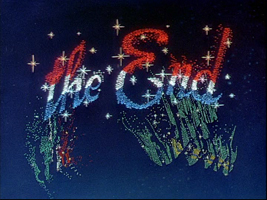
Ed. note: Beth watched the movie soon afterward and has had nearly a month to add her thoughts here in the body of the post itself. But has she? No. Despite my urging. I therefore hereby post it and relegate her thoughts to the comments.
I’m also going to add two links here to other people’s blogs, which I don’t normally do, but these are particularly interesting, I think. This person has uploaded scans of the complete “script” of the movie, which shows which animators were responsible for which shots, but – perhaps more interestingly to the general readership – shows how the surreal action was described. After the fact, I think, but still.
And if you got this far you might enjoy reading this bit of Three Caballeros advocacy. Somewhat over-thought and over-sold if you ask me, but I enjoy any contribution to the conversation on a subject like this.
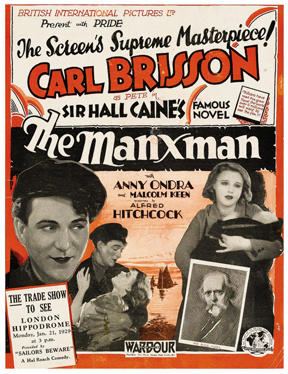 The Ring felt foward-looking and bold in some ways; less so The Manxman, which was pretty much just a typical weepy melodrama for the Mrs. Zero crowd. Both are “two guys one girl” love triangle movies – and in both movies, one of the two guys is played by Carl Brisson – but The Manxman is much soapier and stagier. Odd in fact to see Mr. Brisson’s acting style seemingly regress here in terms of cornball emoting. Though I guess I’m projecting a historical bias in seeing naturalism as progress. His makeup, in contrast to his performance, is actually more naturalistic in this later movie. In The Ring, Brisson has been more touched up with lipstick and eyeliner than his rival; in The Manxman it’s the other way around. I tried to figure out what the “lipstick and eyeliner” look was supposed to connote back then, character-wise, but couldn’t. In both movies, Brisson is the younger and more naive of the two men. In The Ring our sympathies are pretty much entirely with him; in The Manxman they are more divided – all the better to jerk your tears with! So anyway, I don’t know what 20s audiences saw in that look, but I’ll tell you what I see: a guy wearing lipstick and eyeliner.
The Ring felt foward-looking and bold in some ways; less so The Manxman, which was pretty much just a typical weepy melodrama for the Mrs. Zero crowd. Both are “two guys one girl” love triangle movies – and in both movies, one of the two guys is played by Carl Brisson – but The Manxman is much soapier and stagier. Odd in fact to see Mr. Brisson’s acting style seemingly regress here in terms of cornball emoting. Though I guess I’m projecting a historical bias in seeing naturalism as progress. His makeup, in contrast to his performance, is actually more naturalistic in this later movie. In The Ring, Brisson has been more touched up with lipstick and eyeliner than his rival; in The Manxman it’s the other way around. I tried to figure out what the “lipstick and eyeliner” look was supposed to connote back then, character-wise, but couldn’t. In both movies, Brisson is the younger and more naive of the two men. In The Ring our sympathies are pretty much entirely with him; in The Manxman they are more divided – all the better to jerk your tears with! So anyway, I don’t know what 20s audiences saw in that look, but I’ll tell you what I see: a guy wearing lipstick and eyeliner.